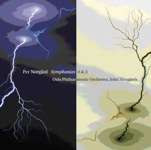|
Back
08/24/2016
Per Nørgård: Symphony No. 2 – Symphony No. 6, “At the End of the Day”
Oslo Philharmonic Orchestra, John Storgårds (conductor)
Recording: Oslo Konserthus (May 2015) & Oslo Opera House (June 2015) – 54’21
DaCapo 6.220645 – Booklet in English, Danish
   

Per Nørgård: Symphony No. 4, “Indian Rose Garden and Chinese Witch Sea” – Symphony No. 5
Oslo Philharmonic Orchestra, John Storgårds (conductor)
Recording: Oslo Konserthus (May 2016) & Oslo Opera House (June 2015) – 55’52
DaCapo 6.220646 – Booklet in English, Danish
   

Per Nørgård’s eight symphonies (to date) are gradually coming into their own, becoming more frequently performed outside Scandinavia and accumulating an impressive list of interpretations on recording. John Storgårds’ two new discs on DaCapo feature works that have been recorded by others, but offer incredibly transparent sonics and fantastically accurate playing from the Oslo Philharmonic. Those brand new to Nørgård’s symphonies would do best to begin with the magnificent, choral Third, but Storgårds’ pairing of the linear Second and violently variegated Sixth is also a great starting point.
The Second is the last in a series of Nørgård’s works focusing exclusively on a single idea: the “infinity series.” Treated as it is in the Second, it is mesmerizing and proto-minimalist; the progression of the music gives the impression of repetition, but it is a trick on the memory: nothing is ever really the same as it was before. Beginning with a whisper in the woodwinds, the Second gradually starts to wobble like a perfect, aural panna cotta. Brass and percussion interjections create structural markers that lead organically to the work’s shattering climax.
Of the four works on these two discs, this is the easiest to digest. Careful pacing and patience are as important from the podium as delicate weavings in-and-out from the orchestra, all balanced by bravado, at times unexpected explosions that require perfect placement. Storgårds and his Oslo players accomplish it all, and then some.
The Sixth is a decidedly different affair. The composer re-terms the three “movements” of the piece as “passages,” and asserts that “nothing ever quite adds up, there is always ‘something’ missing.” This may seem like a fault, but if one eschews traditional expectations and submits to Nørgård’s brilliant orchestration and knack for curious, exhilarating juxtapositions, the result is a fascinating listening experience. Like a non-linear movie plot, the work seems to being with a glittering, fading descent coda, only to restart and become vastly exploratory. Various textures are combined and juxtaposed in unexpected but somehow inevitable ways. Sibelius was capable of this, too, as was Nørgård’s other symphonic forebear and fellow Dane, Carl Nielsen. There is a lot to absorb in the work, and it makes prodigious demands on all sections of the orchestra. Here, rhythmic coordination between variously stratified layers of the ensemble is what makes the music tick, as well as turn-on-a-dime arrivals.
The pairing of the Fourth and Fifth, identical to Leif Segerstam’s Danish recordings on Chandos, is a tougher nut to crack. Inspired by the fantastic artwork of Adolf Wölfli, whose asylum oeuvres are worth getting to know, the Fourth is neatly divided into the wave-like unfolding of the “Indian Rose Garden” and the raucous “Chinese Witch Sea.” It is the shortest symphony of the four presented, and the second half is especially exhilarating. Continuing with the strong performances, there is much to admire here, specifically the stratospheric trumpet passagework and Dolphy-esque bass clarinet lines.
The Fifth is more abstract and difficult. Nørgård states “ the listener´s experience of form in the work will…depend on the directions of his own attention,” and it is easy for one’s attention to wonder, or become wholly submerged and concerned with where one sound came from and where another is leading. By the time such thoughts are considered, however, the work pulls us into another world altogether. It is labyrinthine listening, but it is worth seeing the piece through to the extravagant, shimmering final moments. If the Fourth was based on the enchanting insanity of Wölfli’s art, the Fifth seems to have burst forth as Nørgård’s own controlled chaos.
Storgårds’ introductory essay included in both recordings, and his commissioning of Nørgård’s Eighth, speak to his devotion to this music, and the Oslo musicians play the music expertly. The liner notes, by Jens Cornelius, are informative but tend to wax poetic. In sum, these are handsome additions to the Nørgård discography and, given the interpretive potential within each symphony, additional viewpoints will only shed more light on these fascinating creations.
Marcus Karl Maroney
|